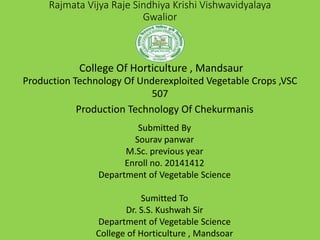
Production of Chekurmanis
- 1. Rajmata Vijya Raje Sindhiya Krishi Vishwavidyalaya Gwalior College Of Horticulture , Mandsaur Production Technology Of Underexploited Vegetable Crops ,VSC 507 Submitted By Sourav panwar M.Sc. previous year Enroll no. 20141412 Department of Vegetable Science Sumitted To Dr. S.S. Kushwah Sir Department of Vegetable Science College of Horticulture , Mandsoar Production Technology Of Chekurmanis
- 2. Botanical name : Souropus androgynus L. Family : Phyllanthaceae Origin : South Asia 2n : 12 Plant part used : Leaves
- 3. Introduction Chekurmanis (Sauropus androgynus L.) of the family Phyllanthaceae is a perennial small shrubby leafy vegetable growing wildly in South and Southeast Asia. The plant is native of India and Burma region. It is found in the Sikkim, Himalayas, Khasi and Akra hills at 1200m elevations and in the Western ghats of Kerala from Wynad northwards at an altitude of 300- 1200m. It is reported to be introduced into Kerala from Malaysia in 1953 and is known in Malayalam as „Madura keera‟. Chekurmanis occupy a prominent place in almost all household kitchen gardens of Kerala but has not been
- 4. The plant is a slow growing glabrous perennial shrub and attain a height of 2-3.5m. Its main branches are terete and flaccid. Lateral branches are thin. Leaves are ovate, oblong, sessile, alternate, membranous and short stacked. The inflorescence is auxiliary with small reddish flowers. Flowers are monoecious, minute, auxiliary, pedicelled and clustered. Fruits sessile, white or pinkish-white,0.2cm in diameter with a fleshy epicarp. The crop is highly crosspollinated and entomophilous because of photogynous and monoecious nature of flower. As a leafy vegetable, it is usually maintained as a perennial plant at a height of 1-1.5m by frequent harvest of leaves and apical system.
- 5. Distribution and Propagation Chekurmanis grows rapidly in hot humid conditions but becomes relatively dormant in cooler environments. It appears to have originated from the hot humid lowland rainforest of Borneo and its present distribution spans from India and South China, through Indo- China and Malaysia to the Philippines, New Guinea and Solomon islands. It is more vigorous at lower altitudes but also grow up to an altitude of 1300 m in Malaysia and Indonesia. In India, the shrub is reported to be found in Sikkim Himalayas, Khasi, Abor and Aka hills and in the Western Ghats of Kerala at altitudes of 600-1200 m. It is said to have got introduced into Kerala from Malaysia in 1953. Reports of its occurrence in the peninsular India from the evergreen forests, clearings, scrub vegetation, roadsides and on waste grounds in Coimbatore, Madurai, Nilgiri, Tiruchirappalli, Tirunelveli and several other parts are available in literatur
- 6. Nutritive value Nutitions % part Moisture 85.5 Carbohydrate ----- Fiber 1.75 Protien 5.25 Lipid 0.58 Energy -------
- 7. Uses and food preparation The leaves, tender shoots and fruits are used either as raw or as cooked vegetable. Cooked leaves are acidic and are used in soup preparation in Java. A sweetmeat is also prepared from the fruits there . In Indonesia, the leaves are reported to be used for giving light green colour in pastry and fermented rice. Leaves are used in sandwiches, salads, curries, meat, rice
- 8. Anti nutritional value As the leaves contain significant amount of ‘pipevarine’, sometimes excessive consumption of raw leaves maycausedizziness, drowsiness, constipation and respiratory disorder
- 9. Soil and climatic conditions It comes up well in all types of soils. The growth and yield are high when they are grown in rich, well drained sandy loam or semi-laterite soils. A warm humid climate with good rainfall is best suited and its grows luxuriantly at a lower elevations at 500m above MSL though plants are found at higher elevations up to 1,200m above MSL. When the plants are raised under shade, it produces broader leaves. There are no distinct varieties or types available in this crop.
- 10. Propagation by stem cutting Seed propagated plants come to harvest little later than cuttings. Herbaceous stem cuttings (6- 12 months old) may be collected with 5-6 nodes or 20-30cm length and planted in polybags containing manure mixture. Rooting can be harvested by dipping the cuttings in 50ppm IAA/ IBA before planting in polybag. It takes 20- 25 days for rooting. Usually, it is grown as hedge or fence around vegetable plots or in kitchen gardens.
- 11. Planting material required For planting a hectare area, about one lakh cuttings are required. Season for planting The cuttings are planted in shallow furrows at least 15 days earlier to the onset of monsoon during April- May.
- 12. Mannuring and fertilizer applications If the crop is planted in pits (30cm3 size), 5 kg of farmyard manure is added in additionto 25g each of urea, superphosphate and muriate of potash. Application of 30g of 7:10:5 NPK mixture per plant supplemented with 1 % urea spray after each clippings enhances leaf yield considerably.
- 13. Harvesting The first clipping of succulent leaves can be done 3- 4 months after plantings, i.e, when the plant reaches about 60-90cm height subsequently in every fortnight, another harvest is possible, if the plants are manured and irrigated. Plants are usually trimmed to 1- 1.5m height to facilitate easy harvest. The tender shoots and leaves are used for culinary purpose.
- 14. Yield The annual productivity is 30-50 tonnes/ha with a per plant yield of 1- 3kg leaves per year
- 15. Refrence Padhari G. Gargi , Chekurmanis; The MultivitaminGreen ,March 2021, Just Agriculture ,Volume 1 ,issue 7 Chttarjee Shubhrajyoti , Nutrition Status Of Chekurmanis,2019 ,Reaserchgate.com/Publication/331824239
- 16. THANK YOU